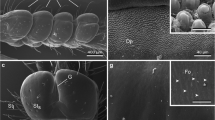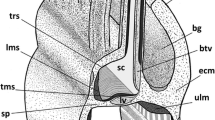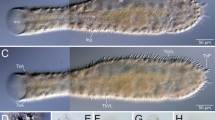Summary
The pulvilli ofCalliphora erythrocephala were examined by light microscopy, fluorescent light microscopy, SEM and TEM. The adhesive secretion was compared with the general surface lipid layer by means of thinlayerchromatography.
On the ventral surface the pulvilli bare several thousand long, slender tenent hairs with solelike spatulate tips. The pulvillar cuticle is composed on the whole of elastic cuticle types (endocuticle, mesocuticle) with specific modifications of structure. The pulvilli contain a secretory epithelium without transport ducts which has lipid and proteinaceous inclusions.
The pulvillar secretion is a slowly volatile oily liquid which is not identical to the general surface lipid. The secretion is stored in the homogeneous cuticle within the pulvillus and transported to the ventral surface via the pore canal system.
The correlation between the structure of pulvilli and their function in the adhesion process is discussed here.
Zusammenfassung
Die Pulvillen vonCalliphora erythrocephala wurden licht und fluoreszenzmikroskopisch, raster- und transmissions-elektronenmikroskopisch untersucht. Das Adhäsionssekret wurde dünnschichtchromatographisch mit dem Körperoberflächen-Lipid verglichen.
Die Pulvillen tragen auf der Ventralseite mehrere Tausend langer dünner Hafthaare mit sohlenartigen Endverbreiterungen. Die Kutikula des Pulvillus besteht hauptsächlich aus elastischen Kutikulatypen (Endo- und Mesokutikula) in verschiedenen, spezifischen Ausbildungsformen.
Die Pulvillen enthalten ein sekretorisches Epithel ohne Ausführgänge, das Protein- und Lipideinschlüsse zeigt.
Das Pulvillensekret ist eine schwerflüchtige, ölige Flüssigkeit, die nicht identisch ist mit dem Körperoberflächen-Lipid. Das Sekret wird in der homogenen Kutikala des Pulvillus gespeichert und über das Porenkanalsystem der Ventralseite nach außen geleitet.
Der Zusammenhang zwischen der Struktur der Pulvillen und ihrer Rolle beim Adhäsionsvorgang wird diskutiert.
Similar content being viewed by others
Abbreviations
- bl:
-
Basales Labyrinth
- cv:
-
coated vesicle
- db:
-
dense body
- dlk:
-
Dichter Lamellenkörper
- dw:
-
Dorsalwand
- e:
-
Epithel
- ef:
-
Endokutikulafasern in der „Übergangszone“ (meso 2b)
- endo 1:
-
lamelläre Endokutikula
- endo 2:
-
homogene Endokutikula
- endo 3:
-
gelatinöse Endokutikula
- ep:
-
Empodium
- epi:
-
Epikutikula
- exo:
-
Exokutikula
- fr:
-
Fersenregion
- fs:
-
Faltensaum
- hh:
-
Hafthaare
- hs:
-
Haarschaft
- k:
-
Kutikula
- kr:
-
Kralle
- ku:
-
Kutikulinschicht
- l:
-
Lumen
- li:
-
Lipid
- lr:
-
Dorsale Längsrippen
- m:
-
Mitochondrium
- mb:
-
Mesokutikulabalken in der „Übergangszone“ (meso 2b)
- meso 1:
-
helle homogene Mesokutikula
- meso 2a:
-
dunkle homogene Mesokutikula, kompakt
- meso 2b:
-
„Übergangszone“, in der dunkle homogene Mesokutikulabalken mit faseriger Endokutikula verzahnt sind
- mt:
-
Mikrotubulus
- mvbd:
-
Dunkler multivesikulärer Körper
- n:
-
Kern
- pc:
-
Porenkanal
- ps:
-
Proximalsklerit
- pt:
-
Prätarsus
- rer:
-
Rauhes endoplasmatisches Retikulum
- s:
-
Schulter
- sd:
-
Sehnendrüse
- se:
-
Sehne
- so:
-
Sohle
- sr:
-
Saumregion
- t:
-
Tubulus
- t5 :
-
Tarsalglied 5
- ta:
-
Tasche
- td:
-
Tarsaldrüse
- te:
-
Tarsalepithel
- tg:
-
Taschengrund
- tk:
-
Terminalkanäle
- utr:
-
Unguitractor
- v:
-
Heller Vesikel
- va:
-
Proteinvakuole
- w:
-
Wachsschicht
- z:
-
Zementschicht
Literatur
Altner, H.: The microfiber texture in a specialized plastic cuticle area within a sensillum field on the cockroach maxillary palp as revealed by freeze fracturing. Cell Tiss. Res.165, 79–88 (1975)
Arnold, J.W.: Adaptive features on the tarsi of cockroaches (Insecta: Dictyoptera). Int. J. Insect Morphol. and Embryol.3, 317–334 (1974)
Bauchhenß, E., Renner, M.: Pulvillus ofCalliphora erythrocephala Meig. Int. J. Insect Morphol. and Embryol.6, 225–227 (1977)
Clearwater, J.R.: Structure development and evolution of the male pheromone system in some Noctuidae (Lepidoptera). J. Morphol.146, 129–176 (1975)
Dahl, F.: Beiträge zur Kenntnis des Baues und der Funktion der Insektenbeine. Arch. Naturgesch.50, 146–193 (1884)
Dahl, F.: Die Fußdrüsen der Insekten. Arch. Mikr. Anat.25, 236–263 (1885)
Dewitz, H.: Die Befestigung durch einen klebenden Schleim beim Springen gegen senkrechte Flächen. Zool. Anz.6, 273–274 (1883)
Dewitz, H.: Über die Fortbewegung der Tiere an senkrechten glatten Flächen vermittels eines Secretes. Arch. ges. Physiol.33, 440–481 (1884)
Eisner, T., McHenry, F., Salpeter, M.M.: Defense mechanisms of arthropods. XV. Morphology of the quinone-producing glands of a tenebrionid beetle (Eleodes longicollis Lec). J. Morph.115, 355–400 (1964)
Ernst, V.V.: The digital pads of the tree frogHyla cinerea. II. The mucous glands. Tissue and Cell5, 97–104 (1973)
Filshie, B.K.: The resistance of epicuticular components of an insect to extraction with lipid solvents. Tissue and Cell2, 181–190 (1970)
Freeman, C.P., West, D.: Complete separation of lipid classes on a single thin-layer plate. J. Lipid Res.7, 324–327 (1966)
Gilby, A.R., Cox, M.E.: The cuticular lipids of the cockroachPeriplaneta americana (L.). J. Insect Physiol.9, 671–681 (1963)
Gillett, J.D., Wigglesworth, V.B.: The climbing organ of an insect,Rhodnius prolixus (Hemipt. Reduviidae). Proc. R. Soc. LondonB 111, 364–376 (1932)
Goodrich, B.S.: Cuticular lipids of adults and puparia of the australian sheep blowflyLucilia cuprina (Wied.). J. Lipid Res.11, 1–6 (1970)
Happ, G.M., Happ, C.M.: Fine structure of the spermatheca of the meal-worm beetle (Tenebrio molitor L.). Cell Tiss. Res.162, 253–269 (1975)
Happ, G.M., Happ, C.M., Barras, S.J.: Fine structure of the prothoracic mycangium, a chamber for the culture of symbiotic fungi, in the southern pine beetle,Dendroctonus frontalis. Tissue and Cell3, 295–308 (1971)
Hasenfuss, I.: Die Herkunft der Adhäsionsflüssigkeit bei Insekten. Zoomorph.87, 51–64 (1977)
Henning, B.: Morphologie und Histologie der Tarsen vonTettigonia viridissima. Z. Morph. Tiere79, 323–342 (1974)
Hiller, U.: Untersuchungen zum Feinbau und zur Funktion der Haftborsten von Reptilien. Z. Morph. Tiere62, 307–362 (1968)
Homann, H.: Haften Spinnen an einer Wasserhaut? Naturwiss.44, 318–319 (1957)
Jackson, L.L., Armold, M.T., Regnier, F.E.: Cuticular lipids of adult fleshflies,Sarcophaga bullata. Insect Biochem.4, 369–379 (1974)
Kendall, M.D.: The anatomy of the tarsi ofSchistocerca gregaria Forskål. Z. Zellf.109, 112–137 (1970)
Lewis, C.T.: Studies concerning the uptake of contact insecticides. I. The anatomy of the tarsi of certain diptera of medical importance. Bull. ent. Res.45, 711–722 (1954)
Locke, M.: Secretion of wax through the cuticle of insects. Nature184, 1967 (1959)
Locke, M.: The cuticle and wax secretion inCalpodes ethlius (Lepidoptera, Hesperiidae). Quart. J. micr. Sci101, 333–338 (1960)
Locke, M.: Pore canals and related structures in insect cuticle. J. biophys. biochem. Cytol.10) 589–618 (1961)
Locke, M.: The structure and formation of the integument in insects. In: The physiology of insecta III. (Rockstein, M. ed.), pp. 379–470. New York-London: Academic Press 1964
Locke, M.: The structure and formation of the cuticulin layer in the epicuticle of an insect,Calpodes ethlius (Lepidoptera, Hesperiidae). J. Morph.118, 461–494 (1966)
Locke, M.: The structure of an epidermal cell during the development of the protein epicuticle and the uptake of molting fluid in an insect. J. Morph.127, 7–40 (1969)
Noble-Nesbitt, J.: The fully formed intermoult cuticle and associated structures ofPodura aquatica (Collembola). Quart. J. micr. Sci104, 253–270 (1963)
Noirot, C., Quennedy, A.: Fine structure of insect epidermal glands. Ann. Rev. Ent.19, 61–80 (1974)
Piek, T.: Synthesis of wax in the honeybee (Apis mellifera L.). J. Ins. Physiol.10, 563–572 (1964)
Quennedy, A.: Les glandes exocrines des termites. I. Etude histochimique et ultrastructurale de la glande sternale deKalotermes flavicollis Fab. (Isoptera, Kalotermitidae). Z. Zellf.121, 27–47 (1971)
Rademakers, L.H.P.M.: Effects of isolation and transplantation of the corpus cardiacum on hormone release from its glandular cells after flight inLocusta migratoria. Cell Tiss. Res.184) 213–224 (1977)
Richards, A.G.: The integument of arthropods. pp. 411 ff. Minneapolis: University of Minnesota Press 1951
Rombouts, J.E.: De la faculté qu'ont les mouches de se mouvoir sur le verre et sur les autres corps polis. Archiv. Mus. Teyler, Sér. II,1, 185–200 (1883)
Roth, L.M., Willis, E.R.: Tarsal structure and climbing ability of cockroaches. J. exp. Zool.119) 483–517 (1952)
Ruppel, H.: Physiologische Untersuchungen über die Bedeutung des Ventraltubus und die Atmung der Collembolen. Zool. Jb. Physiol.64, 429–469 (1953)
Sanford, M.T., Dietz, A.: The fine structure of the wax gland of the honey bee (Apis mellifera L.). Apidologie7, 197–207 (1976)
Sarkaria, D.S., Patton, R.L.: Histological and morphological factors in the penetration of DDT through the pulvilli of several insect species. Trans. Americ. Ent. Soc.75, 71–82 (1949)
Schnepf, E., Wenneis, W., Schildknecht, H.: Über Arthropodenabwehrstoffe. XLI. Zur Explosionschemie der Bombardierkäfer (Coleoptera, Carabidae). IV. Zur Feinstruktur der Pygidialabwehrdrüsen des Bombardierkäfers (Brachnys crepitons L.). Z. Zellf.96, 582–599 (1969)
Simmermacher, G.: Untersuchungen über die Haftapparate an Tarsalgliedern von Insekten. Z. wiss. Zool.40, 481–556 (1884a)
Simmermacher, G.: Untersuchungen über Haftapparate an Tarsalgliedern von Insecten. Zool. Anz.7, 225–228 (1884b)
Slifer, E.H.: Vulnerable areas on the surface of the tarsus and pretarsus of the grasshopper (Acrididae, Orthoptera) with special reference to the arolium. Ann. ent. Soc. Americ.43, 173–188 (1950)
Spurr, A.R.: A low-viscosity epoxy resin embedding medium for electron microscopy. J. Ultrastruct. Res.26, 31–43 (1969)
Stein, G.: Über den Feinbau der Duftdrüsen von Heteropteren. Die hintere larvale Abdominaldrüse der BaumwollwanzeDysdercus intermedius Dist. (Insecta, Heteroptera). Z. Morph. Tiere65 374–391 (1969)
Steinbrecht, R.A.: Feinstruktur und Histochemie der Sexualduftdrüse des SeidenspinnersBombyx mori L. Z. Zellf.64, 227–261 (1964)
Stork, N.E., Evans, M.E.G.: Tarsal setae in Coleoptera. Int. J. Insect Morphol. and Embryol.5, 219–221 (1976)
Tartivita, J., Jackson, L.L.: Cuticular lipids of insects. 1. Hydrocarbons ofLeucophaea maderae andBlatta orientalis. Lipids5, 35–37 (1970)
Waku, Y., Sumimoto, K.: Ultrastructure and secretory mechanism of the alluring gland cell in the silkworm.Bombyx mori L. (Lepidoptera: Bombycidae). Appl. Entomol. Zool.4, 135–146 (1969)
Wasserthal, L.T., Wasserthal, W.: Ultrastructure of a scent scale organ with pressure discharge in maleCaligo eurilochus brasiliensis (Fldr.) (Lepidoptera: Brassolidae). Cell Tiss. Res.177) 87–103 (1977)
Weis-Fogh, T.: A rubberlike protein in insect cuticle. J. exp. Biol.37, 889–907 (1960)
Welsch, U., Storch, V., Fuchs, W.: The fine structure of the digital pads of Rhacophorid tree frogs. Cell Tiss. Res.148, 407–416 (1974)
Whitten, J.M.: Coordinated development in the fly foot: sequential cuticle secretion. J. Morph.127, 73–104 (1969)
Wiesmann, R.: Vergleichend histologische Untersuchungen an normalsensiblen und gegen DDT-Substanz resistenten Stämmen vonMusca domestica L. J. Ins. Physiol.1, 187–197 (1957)
Author information
Authors and Affiliations
Rights and permissions
About this article
Cite this article
Bauchhenß, E. Die Pulvillen vonCalliphora erythrocephala (Diptera, Brachycera) als Adhäsionsorgane. Zoomorphologie 93, 99–123 (1979). https://doi.org/10.1007/BF00994125
Received:
Issue Date:
DOI: https://doi.org/10.1007/BF00994125




